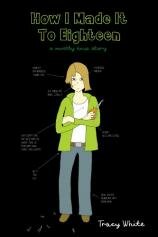Eighteen Is Enough: The Tracy White Interview
Tracy White is the new graphic novel author and illustrator of How I Made it to Eighteen. She is also an avid online comic author, whose site can be found at www.traced.com.
How I Made it to Eighteen may touch on some deep, meaningful, and even sometimes sensitive topics for many teenagers, but it is completely accessible to teachers, parents, and students alike. Honest and unashamed, White’s work is engaging and hard to put down. It’s definite a good, thoughtful read. White discussed the work—and the traumatic time that inspired it—with GraphicNovelReporter.

Recently, there has been a surge in scholarship that suggests that fiction is in its final days, and, in its place, reality-based narratives will rise. Where do you think How I Made It to Eighteen fits within this conversation?
I write stores based on my life because that’s what I’ve always done. I tell stories to reach people. I have this drive to connect to others, to find out (hopefully) that I’m not the only one going through or feeling whatever it is that I am feeling, or have felt. I guess I want to know that I’m not alone.
Numerous times throughout the book and in its publicity, you or your publisher claim that 95% of the narrative is true. If you were asked to put a label on the other 5%, what might that label be?
Five percent = connections between events, people who are made up or just not totally accurate. Although since you asked, I just want to clarify that the comics on my site traced.com are guaranteed 95% true, the book, while mostly true, is a work of fiction.
Your friends (whom you give pseudonyms) offer perspectives that shed light on your well-being during this time in your life. With respect to their privacy and a curious sense of wonder, I want to ask if any of these friends knows about their portrayal in How I Made It to Eighteen. Has there been any response?
You’d think they’d all have read the book, but actually only two friends (and there are five friends that have been squished into four people) have read it. The two are the women Lola and Ashley are based on. “Lola” was really supportive because while she can tell Lola is her, she also sees where the divergence is. “Ashley’s” comment, after telling me she read it in one sitting, was that she felt sad for us because we had to go through that nightmare. Three other friends are waiting for me to visit them and bring the book in person.
I am grateful to them all. While I am often immersed in my teen life (thinking/writing/drawing it), my friends are not. They have, as they should, moved on. So for them, getting a call from me asking about a time that they haven’t revisited in a long while and aren’t necessarily interested in remembering was a jolt. Imagine, there you are in your life doing whatever you do today and you get a call from a friend who’s like “Hey, remember that time when we were both really messed up and really upset? Let’s talk about it in detail.” You know, you may just not want to be pulled into that. To their credit, all of my friends had the patience to put up with my questions and the willingness, on their part, to revisit the past. Not something everyone wants to do.
How I Made It to Eighteen depicts your relationship with your mother as complicated. Reminding me of Alison Bechdel’s complicated and yet powerful relationship with her father in Fun Home, I wonder if it was therapeutic or challenging for you to write about and illustrate this complexity.
I needed to go through therapy to write the book; writing the book wasn’t therapy. In the case of my mom, family therapy after the hospital really, REALLY helped us.
If you were asked to visit a high school and talk about How I Made It to Eighteen, what would you want to say to students and teachers?
Well, I just did that the other day. And aside from answering their very specific questions about characters and incidents in the book, what I wanted them to know, what I want students to know, is this:
- The emotions you feel, when they are really bleak and black, they don’t stay with you forever.
- You are not alone in what you feel.
- That even though I was in four schools in four years during high school and didn’t take SATs, and didn’t go to college when I was 18, and was desperately unhappy and self-destructive—even with all of that, things can still turn out more than okay.
For teachers: I think if the topics (depression, body image, drug use, relationships, to name a few) in this book were text-only, they would be harder to get through. There’s something about images and words together that can make difficult material more accessible.
I was impressed by how clearly and concisely How I Made It to Eighteen addresses complicated and sometimes sensitive subject matter. How were you able to take such heavy subject matter and make it not only accessible, but also friendly?
As I’ve evolved as a storyteller, so has my ability to boil thoughts down to their essence. That’s the art of comics and why I love the medium so much. Whatever you are writing about – reality, fantasy, history, etc.—you still have to take your big complex ideas and express them succinctly.
Your website is awesome! Readers can find it at www.traced.com. What can readers expect from you in the near future?
Thank you! Hard to believe it’s been around for 14 years already. Readers can expect another book and the continuation of TRACED. That said, TRACED is due for an overhaul.
-- Katie Monnin








